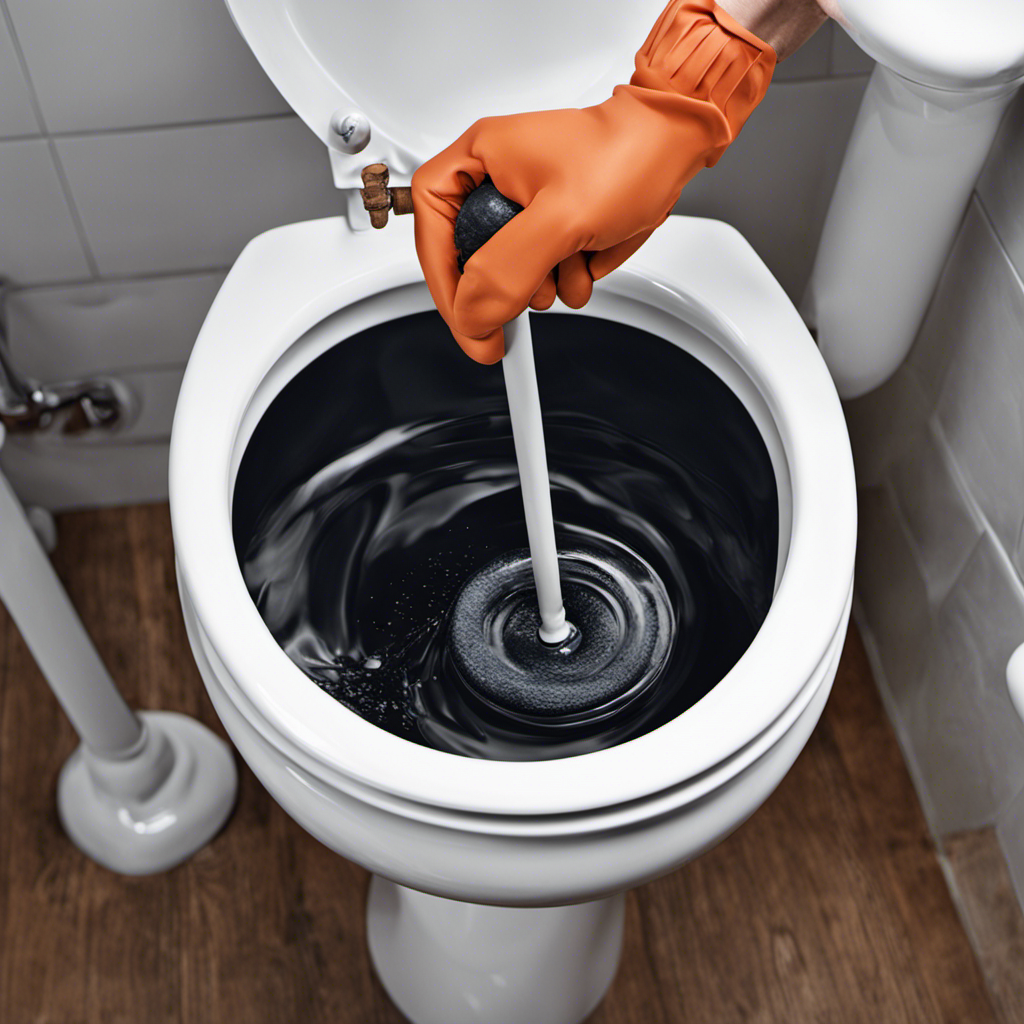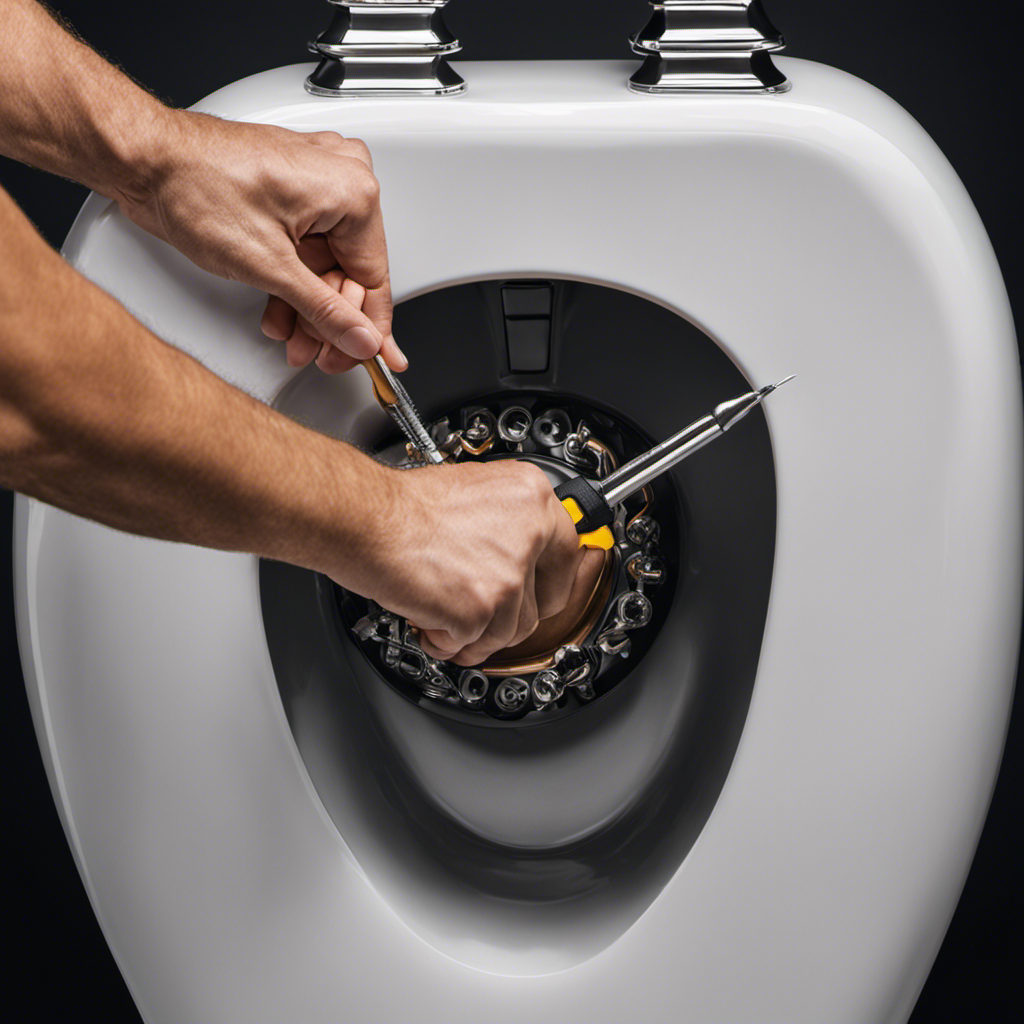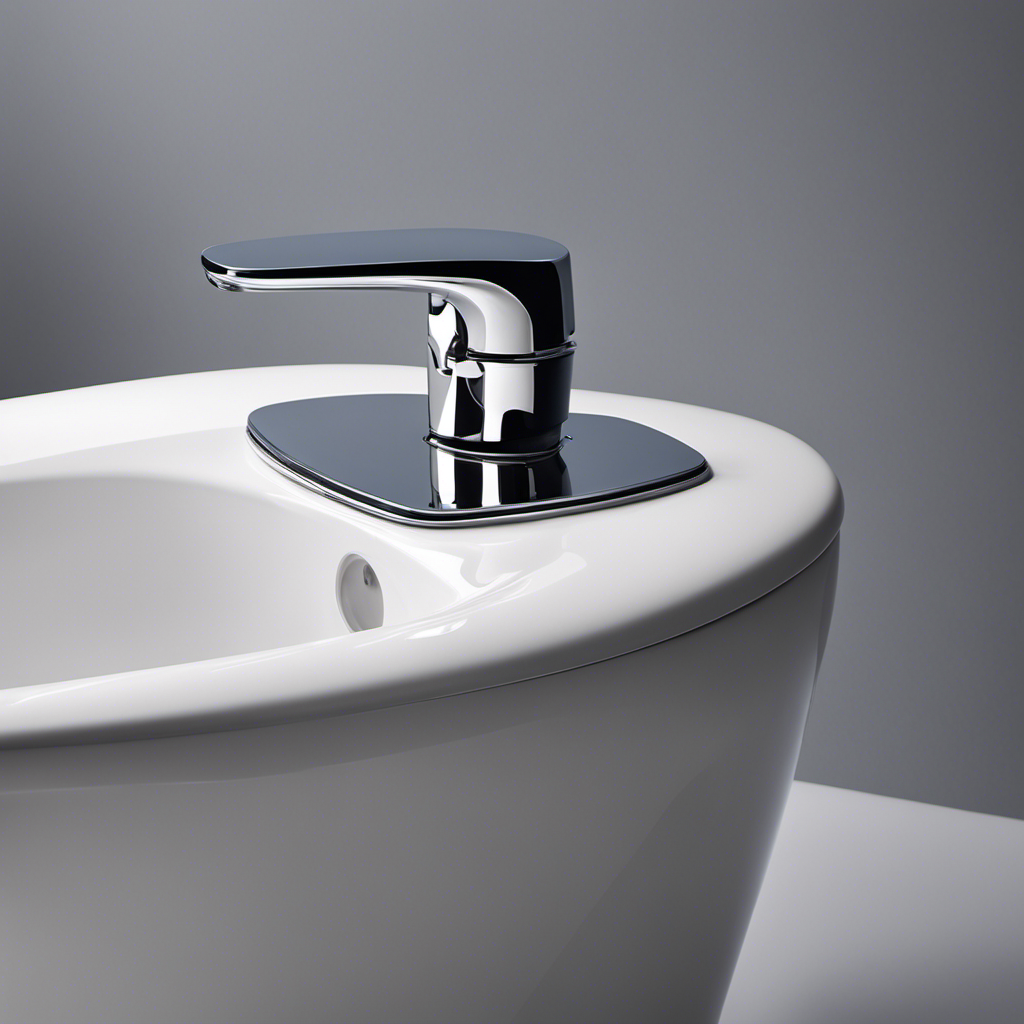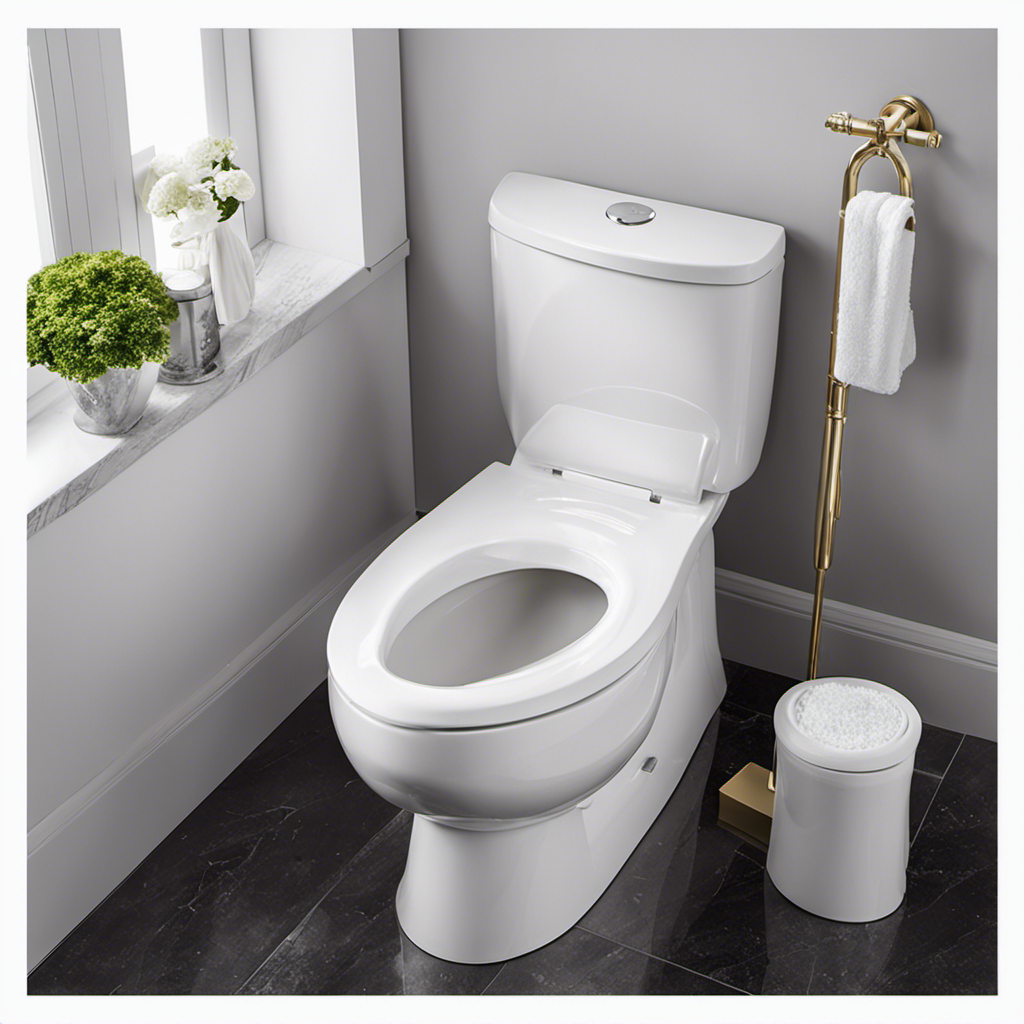So, you’ve found yourself in the delightful situation of dealing with a clogged toilet drain. Fear not, my friend, for I have the solution to your… predicament.
In this handy guide, we will explore the causes of a clogged toilet drain, the tools you’ll need, and a step-by-step process to clear it. We’ll even delve into natural methods and common mistakes to avoid.
Prepare yourself for some practical knowledge that will save you from future plumbing woes. Let’s get down to business, shall we?
Key Takeaways
- Flushing excessive toilet paper and objects other than toilet paper can cause toilet drain clogs.
- Regular maintenance and cleaning, including cleaning the inside of the tank, can help prevent clogs and buildup.
- Using a plunger and an auger (plumbing snake) can effectively clear toilet drain clogs.
- Avoid flushing non-flushable items and regularly clean the toilet bowl to prevent clogs and odors.
Causes of a Clogged Toilet Drain
One of the main causes of a clogged toilet drain is flushing excessive toilet paper. To prevent this issue, it is important to use only the necessary amount of toilet paper and avoid flushing any other objects down the toilet.
Additionally, regular maintenance and cleaning of the toilet drain can help prevent clogs. Chemical drain cleaners can be used as a preventive measure, as they are designed to dissolve any buildup in the pipes and keep the drain flowing smoothly. However, it is important to use them sparingly and according to the manufacturer’s instructions.
In the next section, I will discuss the tools needed to clear a clogged toilet drain and how to use them effectively.
Tools Needed to Clear a Clogged Toilet Drain
When it comes to clearing a clogged toilet drain, it’s important to have the right tools on hand. One of the most common and effective tools is a plunger, which can be used to create suction and dislodge the clog. To use a plunger effectively, make sure to create a tight seal around the drain and use a combination of pushing and pulling motions.
However, for stubborn clogs, an auger can be a helpful tool to have. This long, flexible tool can be inserted into the drain and used to break up or remove the clog.
Plunger Effectiveness and Technique
Using a plunger is an effective and common technique for clearing a clogged toilet drain. I have found it to be the most reliable method in my experience. Here are some tips to ensure the plunger works efficiently:
-
Check the plunger for any damage or wear and tear. Replace it if necessary.
-
Create a proper seal by positioning the plunger over the drain and pressing it down firmly.
-
Use short, vigorous plunges to create suction and dislodge the blockage.
-
Repeat the plunging process several times if needed, until the water starts to drain freely.
While the plunger is a go-to tool, there are alternative methods for clearing a clogged toilet drain, such as using a toilet auger or a chemical drain cleaner. However, these methods should be used with caution and may require professional assistance if the clog persists.
Remember to practice regular plunger maintenance to ensure its effectiveness when needed.
Auger for Stubborn Clogs
To tackle stubborn clogs, you can try using an auger, which is a tool specifically designed to break up and remove blockages in pipes. It’s a handy alternative to using a plunger, especially for more stubborn clogs that won’t budge.
Augers, also known as plumbing snakes, come in various lengths and designs, but they all work on the same principle. You insert the auger into the toilet drain and rotate the handle to maneuver it through the pipes, breaking up the clog as you go.
It’s important to use an auger carefully to avoid damaging your pipes. If you prefer not to use an auger, there are also toilet auger alternatives available, such as using chemicals specifically designed to dissolve clogs safely. Just make sure to follow the instructions and use them cautiously to protect yourself and your plumbing.
Importance of Protective Gloves
Make sure to always wear protective gloves when handling plumbing tools to keep your hands safe from any potential harm. Here are some important things to know about protective gloves:
-
Proper hand hygiene: Before putting on the gloves, wash your hands thoroughly with soap and water. This will help prevent the spread of any germs or contaminants.
-
Different types of protective gloves: There are various types of gloves available, such as latex, nitrile, and vinyl gloves. Each type has its own advantages, so it’s important to choose the right one based on your specific needs and allergies.
-
Latex gloves: These gloves are known for their flexibility and comfort. They provide excellent protection against most chemicals and are suitable for most plumbing tasks.
-
Nitrile gloves: Nitrile gloves are a good alternative for those who are allergic to latex. They offer similar protection and are resistant to punctures and chemicals.
Step-by-Step Guide to Clearing a Toilet Drain
Start by checking if the toilet drain is clogged. If it is, there are a few steps you can take to clear it yourself before resorting to professional plumbing services. First, gather the necessary tools and protective gear, including gloves and goggles. Next, try using a plunger to create suction and dislodge the blockage. If that doesn’t work, you can try using unclogging chemicals specifically designed for toilets. Be sure to follow the instructions carefully and take necessary precautions. If all else fails, it may be time to call in the professionals. They have the expertise and specialized equipment to handle even the toughest clogs. Remember, keeping your toilet drain clear is important for proper functioning and preventing further damage.
| Step | Description |
|---|---|
| 1 | Check if the toilet drain is clogged. |
| 2 | Gather necessary tools and protective gear. |
| 3 | Use a plunger to create suction. |
| 4 | Try unclogging chemicals if necessary. |
| 5 | Call professional plumbing services if all else fails. |
Natural Methods to Unclog a Toilet Drain
When it comes to unclogging a toilet drain naturally, there are a few key methods that are worth trying.
First, using a combination of vinegar and baking soda can help break down any blockages. Simply pour a cup of baking soda into the toilet bowl, followed by a cup of vinegar, and let the mixture fizz for a few minutes before flushing with hot water.
Another effective technique is the hot water flush. Pour a pot of boiling water into the toilet bowl to help dislodge any stubborn clogs.
And finally, the trusty plunger can be a lifesaver when it comes to unclogging toilets. Use firm and consistent plunging motions to create suction and force the clog to break up and move along.
Vinegar and Baking Soda
To begin, you’ll need to gather vinegar and baking soda for clearing the toilet drain. These two household ingredients are effective and safe alternatives to harsh chemical drain cleaners.
Here’s a step-by-step guide on how to use vinegar and baking soda to clear your clogged toilet drain:
- Measure out one cup of baking soda and pour it into the toilet bowl.
- Slowly pour two cups of vinegar into the bowl, being careful not to let it overflow.
- Let the vinegar and baking soda mixture sit in the bowl for about 15 minutes.
- Finally, flush the toilet to see if the clog has cleared.
Vinegar has many benefits, including its ability to break down stubborn clogs and neutralize odors. If you don’t have baking soda on hand, you can also try using lemon juice or hot water as alternatives.
Remember to always exercise caution when dealing with a clogged toilet drain and consider seeking professional help if the clog persists.
Hot Water Flush
If you’re dealing with a clog in your toilet, try pouring hot water into the bowl to help break it down. The hot water technique is a simple yet effective way to clear minor clogs.
First, make sure the water level in the bowl is not too high. Then, heat a pot of water on the stove until it’s very hot but not boiling. Carefully pour the hot water into the toilet bowl.
The heat from the water can help dissolve the clog and loosen any debris that may be causing the blockage. The benefits of using hot water include its ability to soften and break down waste materials. This method is especially useful for clogs caused by organic matter like toilet paper.
However, if the clog persists, it’s time to move on to plunger techniques.
Plunger Techniques
Using a plunger is an effective method for resolving minor clogs in your toilet. Here are four alternative plunger methods that can help you clear your toilet drain:
-
The Bucket Method: Fill a bucket with water and pour it into the toilet bowl with force. The pressure created by the water can dislodge the clog.
-
The Dish Soap Method: Add a few drops of dish soap into the toilet bowl and let it sit for a few minutes. Then, use the plunger to create a strong suction and push and pull vigorously to break up the clog.
-
The Wire Hanger Method: Straighten out a wire hanger and create a small hook at one end. Insert the wire hanger into the toilet drain and gently maneuver it to remove any obstructions.
-
The Hot Water and Epsom Salt Method: Dissolve a cup of Epsom salt in hot water and pour it into the toilet bowl. Let it sit for about 20 minutes and then use the plunger to create a strong suction and dislodge the clog.
Common Mistakes to Avoid When Clearing a Toilet Drain
One of the most common mistakes to avoid when clearing a toilet drain is not using enough water. Many people think that simply plunging the toilet will solve the problem, but often, more water is needed to effectively clear the clog. Here is a step-by-step guide to clearing a toilet drain properly:
| Mistake | Description | Solution |
|---|---|---|
| Not using enough water | Insufficient water can prevent the debris from loosening or flushing away. | Fill a bucket with hot water and pour it directly into the toilet bowl before attempting to plunge. |
| Using the wrong plunger | Using a sink plunger instead of a toilet plunger can be ineffective. | Invest in a quality toilet plunger with a flange at the bottom for better suction. |
| Improper plunging technique | Using too much force or not creating a proper seal can worsen the clog. | Place the plunger over the drain hole, ensuring a tight seal, and use steady, controlled plunging motions. |
Tips for Preventing Future Toilet Drain Clogs
To prevent future clogs, regularly maintain your toilet by using a plunger and pouring hot water down the bowl. This can be helpful.
Here are four additional tips to prevent odors and maintain toilet cleanliness:
-
Use a toilet brush: Scrub the toilet bowl regularly with a toilet brush. This will help remove any stains and buildup that can lead to clogs and unpleasant odors.
-
Avoid flushing non-flushable items: Dispose of items like wet wipes, paper towels, and feminine hygiene products in the trash bin instead of flushing them down the toilet. These items can easily cause blockages.
-
Watch what you flush: Be mindful of what you flush down the toilet. Avoid flushing large amounts of toilet paper at once or excessive amounts of waste. Flushing smaller amounts at a time will reduce the risk of clogs.
-
Regularly clean the tank: Lift the tank lid and clean the inside of the tank at least once a month. This will prevent any buildup of bacteria, mold, or mineral deposits that can affect the cleanliness and odor of your toilet.
Conclusion
In conclusion, unclogging a toilet drain may seem like a daunting task, but with the right tools and techniques, it can be easily accomplished.
Just like clearing a clogged drain, we sometimes encounter obstacles in our lives that prevent us from flowing freely. However, by facing these challenges head-on and using the right tools, we can overcome them and continue on our journey smoothly.
Remember to be patient, take preventive measures, and never hesitate to seek help if needed.
Happy unclogging!










